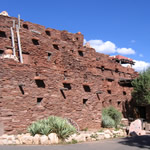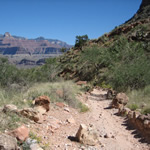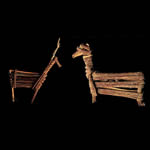The new elementary human history trunk, geared primarily for fourth graders but adaptable for a variety of grade levels, teaches students about human activities and encounters at the canyon throughout time from archaeological data to more current park records. Materials in this trunk are designed to give the young learner a variety of hands-on, minds-on activities to explore and learn about the canyon, bolstering reading, writing, geographical, and historical skills at the same time. This curriculum is aligned with Arizona Standards for Social Studies, Reading, and Writing, and engages the students in practical problem solving.
The lessons identified on this page are part of the Human History trunk available through the Grand Canyon Association in the Elementary Travelin’ Trunk. You may download the PDF of the teacher guide here.
Educators may borrow the Travelin’ Trunks for a two-week period to help their students learn about the Grand Canyon. For more information on ordering a trunk, visit the Grand Canyon Association’s website at http://www.grandcanyon.org/fieldinstitute/educators_trunk.asp
 Photo: Patricia Biggs
Photo: Patricia Biggs Why National Parks?
This lesson helps young students explore the mission and purpose of the National Park system in the United States. It also enables students to identify the southwestern United States, Arizona and Grand Canyon. By...
 Photo: Yolonda Youngs
Photo: Yolonda Youngs Student Created Grand Canyon Folders
In this lesson students create personal folders which may be used to locate the park geographically as well as keep various materials regarding Grand Canyon created in other trunk lessons. The first portion of...
 Photo: NPS
Photo: NPS What is Grand About Grand Canyon?
Upon first seeing Grand Canyon most people stand in awe. Once more is known about the many unique features of the canyon, their awe grows to deep respect for this wondrous natural creation. This...
 Photo: Yolonda Youngs
Photo: Yolonda Youngs Grand Canyon’s Human Timeline
Grand Canyon was already very old when the first humans arrived thousands of years ago. There were small groups of people whose use of this area had little impact on the canyon compared to...
 Photo: Patricia Biggs
Photo: Patricia Biggs Native Americans at Grand Canyon
This lesson reminds students that Native Americans did not disappear from Grand Canyon when European Americans moved west or when the United States established Grand Canyon National Park. They still live, work, and play...
 Photo: Bill Hatcher.
Photo: Bill Hatcher. Early Artifacts of Grand Canyon Peoples
In this lesson students explore evidence of the interaction between early peoples with nature and each other at Grand Canyon. Early Artifacts of Grand Canyon Peoples Lesson Plan Artifacts of Grand Canyon Slide Show
 Photo: NAU, Cline Library
Photo: NAU, Cline Library Growth of Grand Canyon Tourism
The development of comforts and services at Grand Canyon beginning in the early twentieth century made it possible for a growing number of tourists to visit Grand Canyon every year. In this lesson students...
 Photo: NPS
Photo: NPS Architect Mary Jane Colter and Grand Canyon
Mary Colter, working on behalf of Fred Harvey Company, designed buildings with distinctive styles that express a varied human presence at Grand Canyon. Ms. Colter herself, as a female profressional, represents progressive women in...
 Photo: Library of Congress
Photo: Library of Congress Artists and Grand Canyon
Throughout history people arriving at Grand Canyon are awestruck by the enormous vistas before them. Trying to describe the magnificence of the canyon and one’s reaction to it is not easy. Artists of all...
